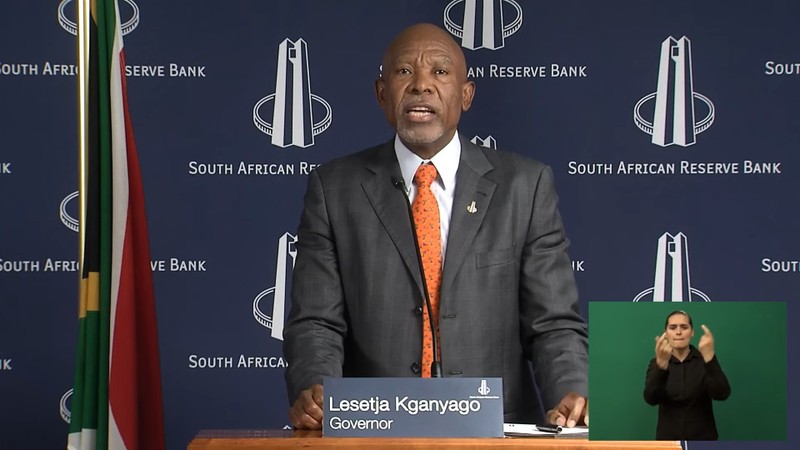
SARB KEEPS INTEREST RATES ON ICE FOR NOW
Lesetja Kganyago, the recently reappointed South African Reserve Bank (SARB) governor, yesterday kept interest rates on ice, dashing hopes for consumers paying back loans who will have to wait until later this year for the Monetary Policy Committee (MPC) to lower rates.
This means that the repo rate will remain at 8.25%, while the prime lending rate also stays at 11.75%.
The governor said that inflation continues to be a problem in the country and around the globe, as well as unemployment rates.
He said, “Since the start of the year, we have seen persistent global inflation pressures. Headline inflation rates are generally lower than they were a year ago, but underlying inflation is still elevated. Goods inflation has declined significantly, as supply shocks wear off, but there is evidence of stronger inflation in services, across a range of economies. Meanwhile, unemployment rates remain low – especially in the US.”
“In these circumstances, major global central banks are expected to cut rates at a slower pace, and to start cutting at a later stage. A few emerging market central banks have been reducing rates already, but these economies had the largest hikes previously, and their interest rates are now well above inflation.”
On South Africa’s ailing economy, the governor pointed out the continued power cuts as one of the main reasons the economy showed such a poor rate of growth in the final quarter of 2023.
Kganyago said, “The economy performed worse than expected in the fourth quarter of last year, expanding just 0.1%. Growth for 2023 as a whole was 0.6%. The main reason for this bad performance was supply-side problems. Electricity load shedding was worse than in previous years. Port and rail problems also emerged as binding constraints on output.”
The SARB forecasts indicated a modest growth acceleration from this year, as these supply-side constraints relaxed.
“In particular, we expect the load shedding burden will ease somewhat. While we estimate electricity shortages took 1.5 percentage points off GDP last year, we think this will moderate to 0.6 percentage points this year and 0.2 percentage points in 2025. Overall, we see growth at 1.2% this year, improving to 1.6% by 2026. These projections are better than the 2023 outcome, but below longer-run averages, which are around 2%,” Kganyago said.
Sanisha Packirisamy, an economist at Momentum Investments said, “We expect the first move lower in interest rates in the second half of the year. In line with the Quarterly Projection Model now only forecasting 50 basis points worth of easing by the end of the year, risks are titled to a shallower interest rate cutting cycle.
“Globally, central banks have adopted a similar stance, acknowledging the drop in inflation but cautioning against policy errors leading to a revival in inflationary pressures spurred on by premature and too aggressive monetary policy easing in an environment where geopolitical pressures remain a key threat to inflation outcomes,” said Packirisamy.
FNB chief economist Mamello Matikinca-Ngwenya said the decision to leave interest rates unchanged came as expected by the market.
While many spectators looked for clues on the start of the cutting cycle, a few factors were worth monitoring.
She said, “Firstly, although the Fed (Federal Reserve) has recently upheld its expectations of 75bps (basis points) of cuts this year, it has revised its 2024 growth and core inflation forecasts upwards and reduced its anticipation of rate cuts over the longer run. This, along with the recent shift in Japan to positive interest rates, emphasises that real interest rates will remain high for long. Nevertheless, the European Central Bank and the Fed are broadly expected to start cutting rates around the middle of the year, which should create some space for the SARB.”
Secondly, the risk premium on South African assets could move further away from the long-term average ahead of the elections, but a reform-friendly outcome should support improved risk sentiment and a recovery in the rand which would entrench the deceleration in inflation in second half of 2024.
“Thirdly, while disinflation is expected in the latter part of the year, upside risk prevails – primarily from adverse weather conditions and cost pass-through pressures. In all, these factors suggests that even as we can hope for lower rates in 2H24, an air of caution should persist, and the eventual cutting cycle will likely be shallow,” Matikinca-Ngwenya said.
Luigi Marinus, PPS Investments portfolio manager, told Business Report that inflation remained within the 3% - 6% target band for the past nine consecutive months the latest print of 5.6% is above the 4.5% unofficial level that the MPC targets.
BUSINESS REPORT
2024-03-28T04:12:17Z dg43tfdfdgfd